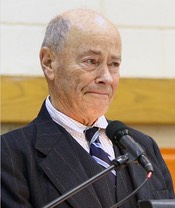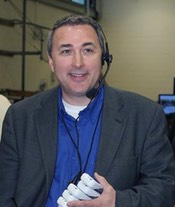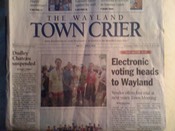The appearance and configuration of electronic voting occured through a series of somewhat unrelated events. But once it got going - all of the events were definitely related !
Spring 2006
A Wayland High School student (unnamed here) submitted a term paper on the subject of electronic voting at town meeting using cell phones. That term paper found its way to former moderator Peter Gossels and ultimately to former board of selectmen member Alan Reiss.
The idea was way ahead of its time. A great idea which imagined town meeting voting not only in the hall but remotely - because it suggested using cell phones. As many ideas which are way ahead of their time, it was not possible to act upon it in the spring of 2006.
November 2009
One of the most difficult Wayland town meetings ever. Many standing counted votes and re-votes. Much contention and bad feelings over decisions of vote outcomes and reconsideration. Alan Reiss, while sitting in the audience, was signaled by an on-looker, to change his public vote (while standing up to vote). This was the point in time where Alan's decision was made to pursue a different voting solution for Wayland's town meeting. A solution which would provide first privacy but would also include the elements of speed and accuracy. From this event an Article 22 was submitted shortly thereafter for the Annual town meeting of 2010. The first electronic voting website is created to spread the word.
April 2010
Although the original article was to purchase a wireless keypad system (using the less expensive non LED displays) and accounted for 2,000 attendees (the maximum capacity of the WHS field house). The cost to purchase this system was $150,000. Knowing that the large cost would (most probably) cause the article to be defeated at that time, three days prior to that town meeting, a specific provider of this equipment was convinced to gift Wayland one town meeting's worth of a turnkey free trial (estimated to be about $30,000). The motion to that article first disclosed on town meeting floor: "Mr Moderator, I move you that the town accept from Options Technologies Interactive, the turnkey demonstration, at no cost of an electronic voting system for annual town meeting 2011". That article, after some lengthy discussion and debate, passed by a voice vote - virtually unanoumously. Electronic voting was coming to New England town meeting and Wayland would be the first.
Summer 2010
In order to implement this system, many factors had to be considered including check in, check out, security, verification and voting procedures. These details also included a change to the moderator's rules. The Electronic Voting Implementation Sub-Committee (ELVIS Chairman Dave Bernstein) was created and worked for one year on the mission to provide the best, free trial one could deliver for annual town meeting April 2011. A Wayland High School student was enlisted to record an informational electronic voting public service announcement. The town of Framingham shows interest in obtaining electronic voting for their REPRESENTATIVE form of town meeting (and ultimately does purchase equipment to do so.)
April 2011 Electronic Voting Used - The Free Trial
The free trial was demonstrated with great success and two test votes were also used (Wednesday and Sunday) to determine the interest that people had for privacy. Respectively, those votes went 69% and 78% in favor of privacy. It was this meeting where the open and close window 'light bulb' idea was suggested and employed. The 'light bulb' widow idea commenced starting the second session. A calculated 175 minutes were saved by avoiding standing counted votes.
Summer 2011
ELVIS V2.0 was reformulated for the purpose of vendor selection. The town administrator had sole responsibility to negotiate prices and he alone had access to the various quotations from at least 6 vendors. Options Technology Interactive was chosen for its advanced technology and also had the best leasing deal available for Wayland. (ELVIS V2.0 remains in place and is on-going but now has switched its purpose to refinement of procedures, handing of special conditions and has also moved into predictive methods of anticipating attendance to optimize keypad ordering for minimium cost.)
November 2011
A citizens called special town meeting for the purpose of disengourgement of excess free cash was held without electronic voting. However, petitioners presented Article 1 which was a resolution for the Board of Selectmen and the Finance Committee to fund electronic voting for Annual town meeting 2012. This resolution passed resoundedly.
April 2012 Electronic Voting Used - Resolution of usage for 3 years - Ending April 2015
Electronic voting is used for Wayland's Annual town meeting 2012. The very last article (Article 31) of that town meeting is a 3 year resolution to lease electronic voting equipment from the chosen vendor for every town meeting and for every session of town meeting. This vote was done as a voice vote since the last night of that town meeting was not funded within the November 2011 resolution. The voice vote pass virtually unanousmly. A calculated 342 minutes were saved by avoiding standing counted votes. We performed our first system audit on the first session of that town meeeting and the system passed 100%.
October 2012 Electronic Voting Used
This Special Town Meeting was the first of the 3 year leasing deal with Options Technologies Interactive. The meeting was done fully with electronic voting and was widely applauded for its efficiency and privacy.
April 2013 Electronic Voting Used
The second town meeting under the lease term was done at annual town meeting. A large number of very close votes with separation of <10% and on 2/3rd's quantum, a calculated 243 minutes were saved by avoiding standing counted votes. Two selectmen from the town of Westborough visit with Alan Reiss and Dave Bernstein in Wayland to discover more about electronic voting. As of this date there are 7 other towns who have considered or are going forward with electronic voting.
November 2013 Electronic Voting Used
The Wayland Fall Town Meeting had 4 main questions. All four articles were disposed of in 2 hours and this included ample discussion on some highly contentious and high expensive issues. The main event of the night was article two - a decision to build or not a brand new Department of Public Works on River Road, near the town landfill. The project had a total borrowing cost of $13.7 Million dollars. Borrowing articles require a 2/3rds quantum (66.66%) to pass. As with all other electronic voting dispositions, article two took 1 minute to process the count of 70% to 30%. With 640 total attendance, this figured to be a differential of about 20 votes (3 1/3%) or a margin (1/2) 20 = 10 (that is, with 10 people changing their minds then the vote would have flipped). Such tight margins would ultimately become standing counted votes. In a tightly packed audience of 640 people (as it was) this may have taken over one hour to adequately perform. The electronic voting went smoothly and it looked so easy. Onward until the next town meeting in April 2014.



